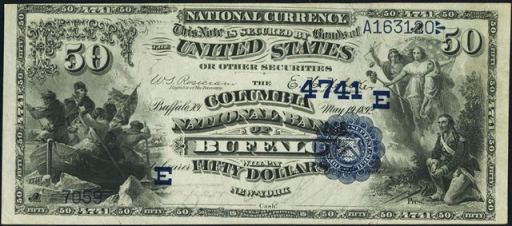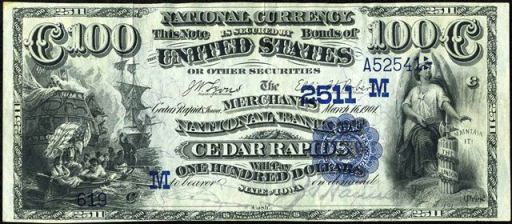The National Howard Bank Of Baltimore
The National Howard Bank Of Baltimore in Maryland printed $1,064,650 dollars worth of national currency. Over $1,000,000 face value is a lot of money. However, some types and denominations of currency from this bank could still be rare. This national bank opened in 1890 and stopped printing money in 1915, which equals a 26 year printing period. That is a fairly normal lifespan for a national bank. During its life, The National Howard Bank Of Baltimore issued 7 different types and denominations of national currency. We have examples of the types listed below. Your bank note should look similar. Just the bank name will be different. For the record, The National Howard Bank Of Baltimore was located in Independent City County. It was assigned charter number 4218.
We buy all national currency. Please call or email us for a quote. Sales@AntiqueMoney.com
The National Howard Bank Of Baltimore in Maryland printed 2,640 sheets of $50 1882 brown back national bank notes. Not many banks printed $50 1882 brown backs. Sheet outputs aren’t extremely important. However, it is good factual information to know. The most common 1882 $50 brown backs are worth about $5,000. However, some can be worth more than $10,000 based on condition, serial number, and bank of issue.
Series of 1882 $50 Brown Back
The National Howard Bank Of Baltimore printed 2,640 sheets of $100 1882 brown back national bank notes. Just because this bank printed more than 1,000 one hundred dollar brown backs does not mean that they are all common. We are very interested in purchasing $100 1882 brown back national bank notes. We have paid more than $15,000 for some examples. Send us pictures of what you have and we will respond quickly with an appraisal and offer.
Series of 1882 $100 Brown Back
The National Howard Bank Of Baltimore also printed 953 sheets of $50 1882 blue seal national bank notes. High denomination 1882 blue seals like this are not frequently encountered, regardless of the number of notes printed. There is a big difference between the two types of 1882 $50 blue seals. The variety that says “1882-1908” on the back is rare, but no where near as rare at the type that says “Fifty Dollars.” The second variety is extremely rare and only about a half dozen are known to exist. The first type should still be worth at least $4,000. The second type is a five figure rarity though.
1882 Blue Seal $50 National Bank Note
The National Howard Bank Of Baltimore also printed 953 sheets of $100 1882 blue seal national bank notes. The number of sheets printed doesn’t matter too much here. All 1882 $100 blue seals are rare. They were issued by a total of 256 total national banks in the country. The rare 1882 value backs were only printed by banks in Dayton, Ohio and New Orleans, Louisiana. The slightly more common date backs are much more plentiful but still rare in the scheme of things.
1882 Blue Seal $100 National Bank Note
The National Howard Bank Of Baltimore also printed 8,990 sheets of $5 1902 blue seal national bank notes. That is a fairly standard sheet output for a national bank issuing blue seals. You likely aren’t dealing with a super common or a super rare bank note. Ben Harrison is on the front of all 1902 $5 blue seal bank notes. This happens to be the smallest denomination issued for the 1902 series. Each note is complete with a blue seal and blue charter number. Despite saying series of 1902, these were actually issued by national banks between 1908 and 1928. There are two different types of blue seals. The first type is called a date back and it has “1902-1908” written on the back of the bill. The other type is called a plain back; it does not have the date stamps on the back of the bill. The values for these notes range widely based on condition and the bank of issue.
1902 $5 Blue Seal National Bank Note
The National Howard Bank Of Baltimore also printed 6,918 sheets of $10 1902 blue seal national bank notes. That is a fairly standard sheet output for a national bank issuing blue seals. You likely aren’t dealing with a super common or a super rare bank note. 1902 $10 blue seal bank notes all have a portrait of William McKinley on them. Values can range from as little as $40 up to over $10,000. There really is no trick to know what is rare and what is common by just doing an internet search. You really need to work with an expert (like us) in order to determine the value of your specific bank note. There are at least ten different factors than can make some 1902 $10 blue seals worth more than others. We know exactly what to look for and we would be happy to provide a free appraisal and our best offer.
1902 $10 Blue Seal National Bank Note
The National Howard Bank Of Baltimore also printed 6,918 sheets of $20 1902 blue seal national bank notes. The same rarity rules for 1902 $10 blue seals also apply to $20 blue seals. Just remember that $20 bills are by nature three times rarer (unfortunately they don’t command a premium over other denominations). Hugh McCulloch is pictured on the front of each bill. Contact us if you need pricing help.
1902 $20 Blue Seal National Bank Note



